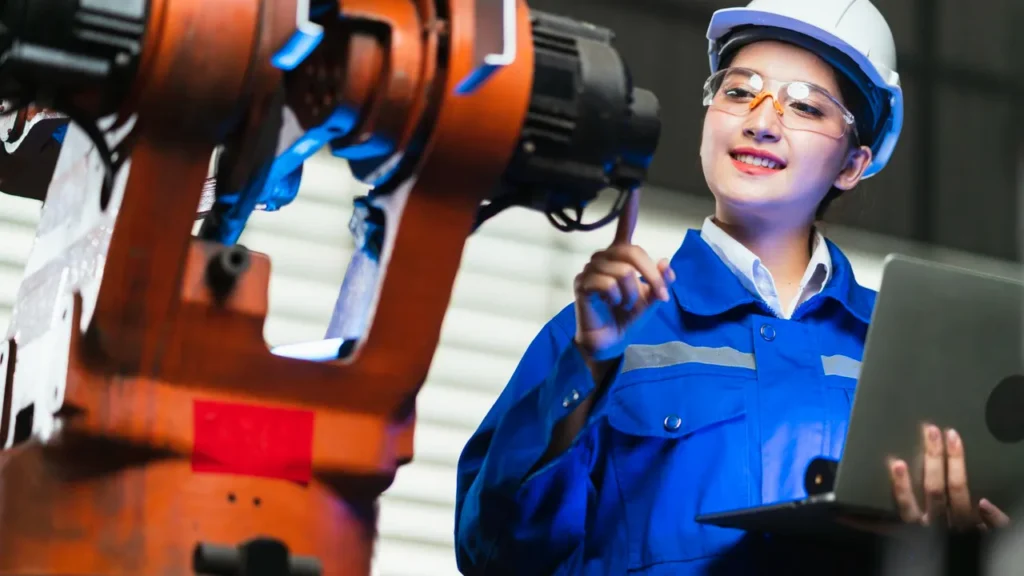The shift toward a smart manufacturing workforce is one of the most significant changes happening in the industrial world today. As factories adopt connected systems, automation, and advanced data-driven tools, the roles and skills required from workers evolve rapidly. Instead of relying solely on manual labor, modern manufacturing now blends technology, human expertise, and continuous learning to stay competitive in the Industry 4.0 era.
This transformation is not just about machines replacing people. It’s about redefining how humans and technology collaborate, how companies train their employees, and how workers adapt to constant innovation. With smart factories becoming more common, driven by systems like the Internet of Things (IoT) and Artificial Intelligence (AI), the demand for skilled, digitally capable employees continues to grow.
Understanding the Smart Manufacturing Workforce
A smart manufacturing workforce refers to employees who can operate, manage, and optimize technology-enhanced production environments. Instead of performing repetitive tasks, workers now focus on supervision, data interpretation, problem-solving, and system improvement. Smart manufacturing integrates automation, robotics, real-time analytics, and interconnected machines, turning traditional factories into intelligent production ecosystems.
One of the biggest drivers behind this shift is the growing presence of advanced machines such as industrial robots. These robots handle tasks like welding, packing, and material handling with precision and efficiency. However, they still require trained human operators to program, maintain, and troubleshoot them.
Key Drivers Behind Workforce Transformation
Industry 4.0 Adoption
The rise of Industry 4.0 has accelerated the need for a smarter workforce. Industry 4.0 focuses on digital production, cyber-physical systems, automation, and connectivity. Smart factories collect data from machines, analyze it in real time, and adjust operations automatically. To support this ecosystem, companies need employees who understand technology and can adapt to new tools quickly.
Digital Training and Skill Adaptation
The need for digital training has become essential. Workers must learn how to operate digital interfaces, interpret data dashboards, and use simulation-based tools. Many manufacturers now invest in online learning platforms, VR-based training, and guided machine operation tutorials. This helps employees adjust to rapidly changing environments and build confidence in using advanced systems.
Automation and Job Redefinition
Automation continues to reshape factory roles. Instead of eliminating jobs, automation often changes job responsibilities. Machines take over repetitive and physically demanding tasks, while humans move into roles focusing on monitoring, decision-making, and system optimization. This shift allows workers to contribute more value through creativity and critical thinking.
Essential Skills for the Smart Manufacturing Workforce
Technical Competencies
- Data analytics and interpretation
- Machine operation and programming
- Robotics maintenance and troubleshooting
- Understanding of networked systems
Technical skills are becoming increasingly important as factories depend on digital systems. Workers who can analyze production data, detect patterns, and optimize machine performance are highly valuable.
Soft Skills
- Problem-solving
- Adaptability
- Communication
- Collaboration
Soft skills play a major role in supporting a smart manufacturing workforce. Technology alone cannot solve every issue on the factory floor. Workers must be able to identify root causes, communicate solutions, and collaborate across teams.
This evolution aligns with the global shift toward automation, which influences how industries plan their workforce and adapt their operations.
Role of Digital Training in Workforce Transformation
Digital training helps workers gain the skills needed to operate new technologies. Online modules, simulation labs, and interactive tutorials allow employees to learn at their own pace. Virtual and augmented reality are also being used to provide hands-on training without stopping production lines.
Continuous skill adaptation becomes essential as technology evolves. Workers must regularly update their knowledge to remain effective in smart manufacturing environments.
Challenges in Developing a Smart Manufacturing Workforce
Skill Gaps
Many companies struggle to find workers with both technical and digital skills. The gap between traditional manufacturing knowledge and modern technology requirements continues to grow, creating recruitment and training challenges.
Resistance to Change
Some workers fear technology may replace their jobs, leading to hesitation and resistance. However, with proper communication and training, many employees discover that smart systems improve working conditions and open new career opportunities.
Investment Requirements
Training programs and technology upgrades require significant investment. Companies must balance costs with long-term benefits, ensuring that workforce development strategies remain sustainable.
Governments and educational institutions are beginning to support this transition through workforce programs similar to those found in vocational education systems.
Strategies to Build a Future-Ready Workforce
Employer-Led Training Programs
Many companies develop internal academies or partner with universities and technical institutes to provide training. These programs help workers build confidence and maintain productivity while learning new technologies.
Government and Industry Support
Policies and funding initiatives can encourage workforce development by supporting training centers, apprenticeships, and certification programs.
Digital Transformation Roadmaps
Successful companies create roadmaps that align workforce planning with technology adoption. Clear strategies help employees understand expectations and future opportunities.
Case Studies of Successful Workforce Transformation

Several manufacturers have already demonstrated how investing in a smart manufacturing workforce leads to improved efficiency and competitiveness. For example, companies in automotive and electronics sectors have integrated digital monitoring systems, robotics support, and data-driven decision-making. As a result, production accuracy increases while downtime decreases.
One well-known example involves the adoption of collaborative robots, also known as cobots. These machines work alongside humans, assisting with tasks that require precision or repetitive motion. Employees trained to operate and supervise cobots often experience less physical strain and more engaging work responsibilities. This collaboration shows how technology enhances, rather than replaces, human contribution.
Another success story can be seen in manufacturers that implemented advanced data systems and predictive maintenance. By analyzing real-time machine data, workers can anticipate equipment failures and schedule repairs before problems occur. This approach not only reduces downtime but also empowers employees to use analytical thinking and technical problem-solving skills.
Future Outlook for the Smart Manufacturing Workforce
Human-Machine Collaboration
The future of manufacturing will rely heavily on collaboration between humans and intelligent machines. Instead of competing with automation, workers will take on roles that require creativity, oversight, and innovation. Machines will handle repetitive tasks, while humans focus on optimization and improvement.
This trend aligns with broader technological movements such as human–computer interaction, where systems are designed to improve cooperation between people and technology. As this relationship evolves, factories will become more efficient, safer, and more adaptable.
Lifelong Learning Culture
Continuous learning will become a standard expectation for employees in smart manufacturing environments. Technology development is rapid, and workers who remain flexible and proactive in learning new skills will thrive. Many companies are already encouraging lifelong learning through internal training systems and online educational partnerships.
The concept of lifelong learning is supported by educational models similar to those found in continuing education programs, where professionals regularly update their qualifications.
Greater Workforce Diversity
The shift toward digital manufacturing may also attract a more diverse workforce. Roles that once required heavy physical labor now emphasize analytical thinking and digital operation, opening opportunities for more varied candidates. This diversity can improve innovation and problem-solving across manufacturing teams.
Why Workforce Transformation Matters for Industry Competitiveness
Companies that embrace a smart manufacturing workforce gain several advantages, including increased productivity, reduced operational costs, and improved product quality. By empowering employees with digital skills, manufacturers can respond more quickly to market demands and technological advancements.
Workforce transformation also strengthens global competitiveness. Countries and companies that fail to adapt may struggle to maintain relevance as others adopt smarter, more efficient production methods. This makes workforce development a strategic priority rather than an optional improvement.
Building a Sustainable Workforce Strategy
To ensure long-term success, companies must create strategies that balance technology investment with human development. Training programs, career growth opportunities, and supportive workplace cultures all contribute to a sustainable smart manufacturing workforce.
Clear communication is essential. Employees must understand how technology benefits them and how their roles may evolve. When workers feel included in the transition, they are more likely to embrace new tools and contribute positively to organizational goals.
Impact of Smart Manufacturing Workforce on Job Creation
One misconception about the rise of a smart manufacturing workforce is that automation will eliminate most industrial jobs. In reality, many industries are experiencing the opposite effect. As factories adopt smart technologies, new roles emerge that require digital knowledge, system oversight, and technical support. Positions such as data technicians, automation specialists, and maintenance engineers are becoming more common, creating valuable employment opportunities.
For example, the growth of digital production systems has increased demand for employees who understand data analysis and can use insights to optimize production. Instead of performing repetitive tasks, workers now contribute through decision-making and strategic improvements. This shift leads to higher job satisfaction and stronger career development prospects.
Smart manufacturing also encourages collaboration between departments that traditionally worked separately. Production teams now interact closely with IT and engineering departments, creating a more integrated workplace environment. This cross-functional teamwork increases efficiency and supports innovation, which helps companies remain competitive in fast-changing markets.
In the long term, a well-developed smart manufacturing workforce can boost regional economic growth. Areas that invest in modern manufacturing capabilities often attract new businesses, research institutions, and training programs, creating a positive cycle of development.
Conclusion
The transformation toward a smart manufacturing workforce represents a major shift in how factories operate and how employees contribute to productivity. Instead of replacing humans, technology enhances their capabilities, allowing them to perform more meaningful and innovative tasks.
By investing in digital training, supporting skill adaptation, and fostering a culture of lifelong learning, manufacturers can build resilient teams ready to thrive in the Industry 4.0 era. Companies that successfully navigate this transition will enjoy increased efficiency, improved product quality, and stronger competitive positioning in the global market.
Ultimately, the future of manufacturing depends on collaboration—between technology, skilled workers, and forward-thinking organizations committed to growth and innovation.



